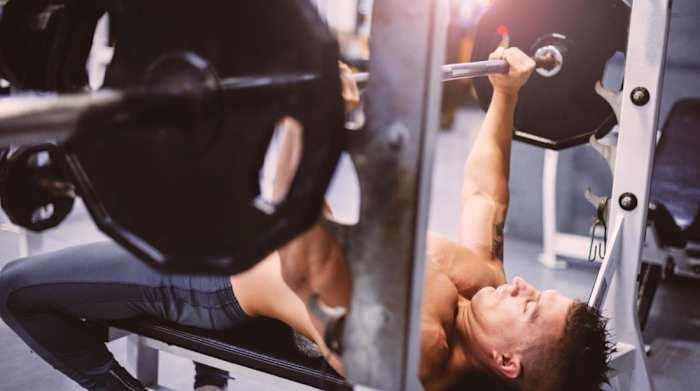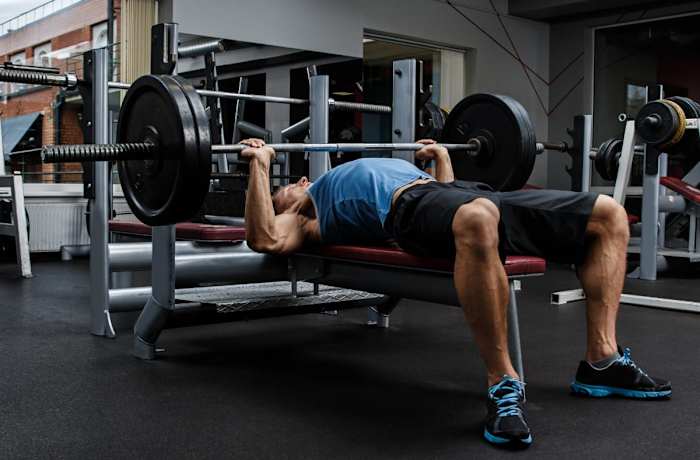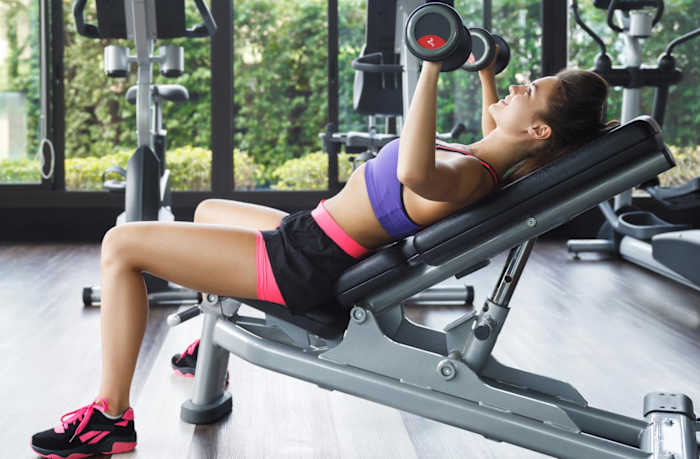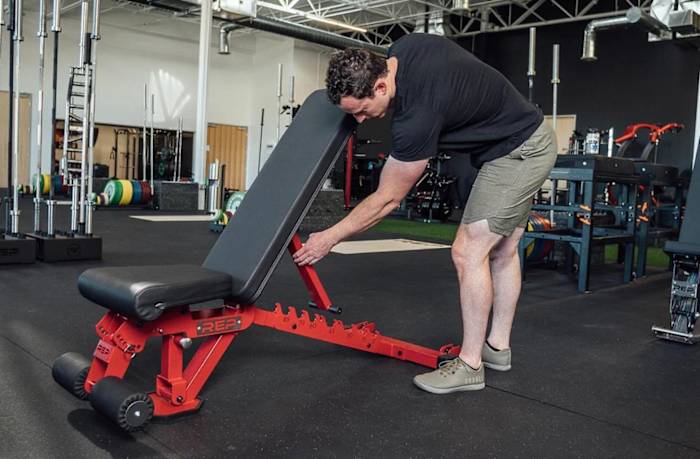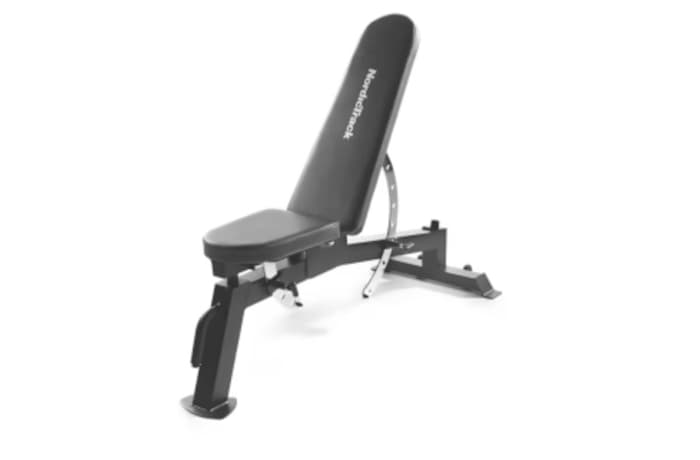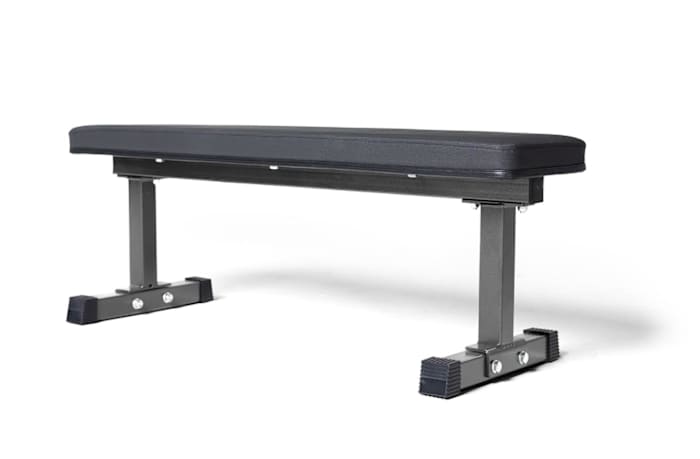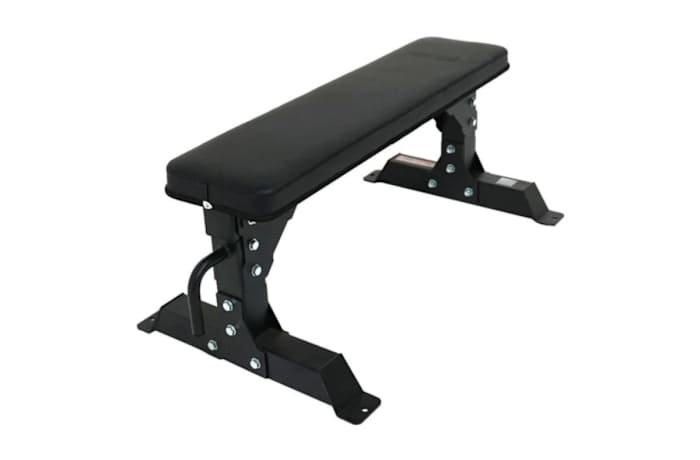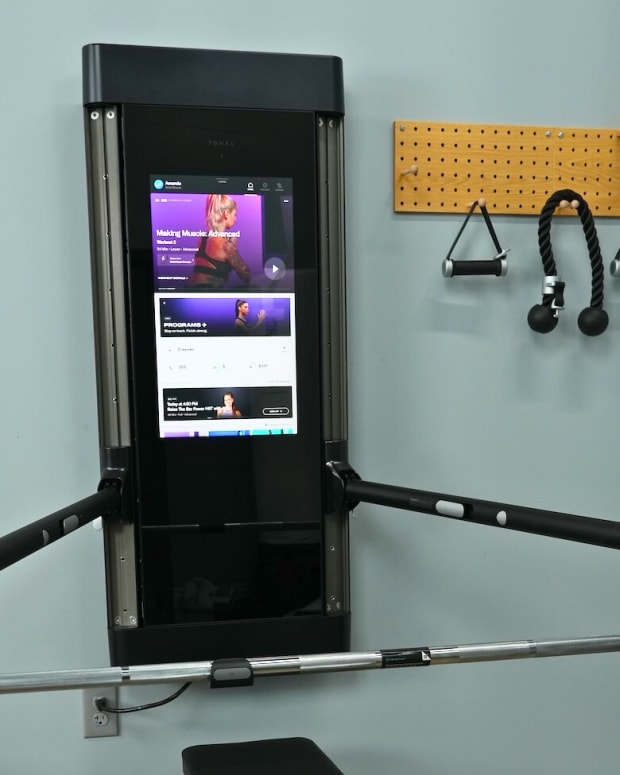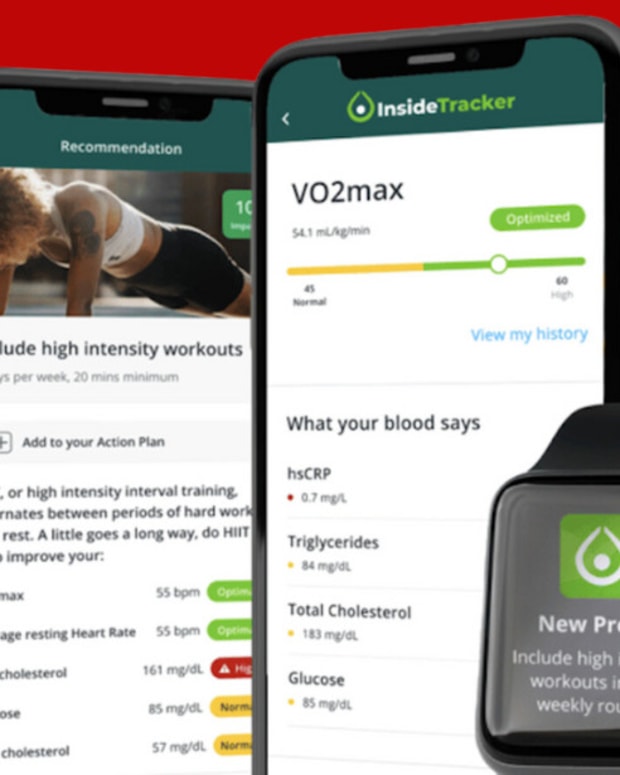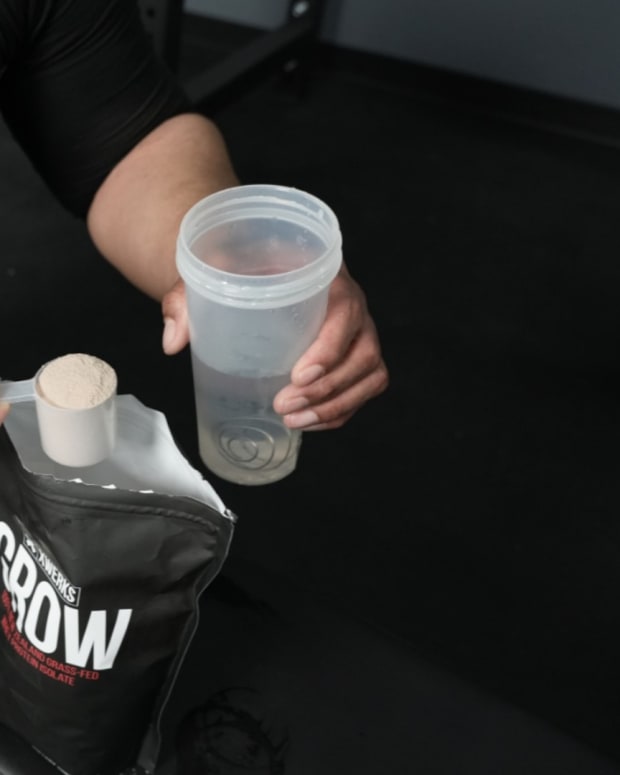The products featured in this article have been independently reviewed. When you buy something through the retail links on this page, we may earn commission at no cost to you, the reader. Sports Illustrated editorial staff are not involved in the creation of this content. Learn more here.
An integral part of building strength and a toned physique is developing a strong upper body. And yes, while having a strong upper body is definitely sexy to look at, it serves many purposes far beyond that. Our everyday activities become easier with it—like finally being able to get groceries into the house in one go—and it includes several major muscle groups, such as your chest and pectoral muscles, which are necessary to train for better muscle balance and overall functional fitness.
Strengthening your chest requires various movements and tools. In the fitness equipment hall of fame, even higher than dumbbells, the bench is a reigning champ—it’s one of the most widely used and crucial pieces of gym equipment that assists in increasing the strength and size of your chest, regardless of whether you're a beginner, a bodybuilder or anyone in between.
Although flat benches get most of the attention, you may have noticed incline benches and wondered whether they are for you. Here, we’ll explain the differences between flat and incline benches (including how they affect performance during key exercises), when each bench press variation is appropriate to use in your workout routine and which is best suited to your fitness goals. Plus, we'll even throw in a few exercise tutorials to get you started.
Key Differences
- Flat benches are completely parallel to the ground, whereas incline benches are placed at a 15- to 60-degree angle.
- Flat benches put more emphasis on the lower pecs (lower chest), while incline benches put more emphasis on the upper pec, clavicular head (upper chest) and deltoids (shoulders).
- Flat benches usually allow you to stack more weight and lift more, since your entire chest is targeted.
Key Similarities
- Both are used to work your chest muscles, as well as anterior deltoids, triceps, back and even abs if done correctly.
- Both are versatile pieces of equipment that can be used for multiple exercises.
- Each bench can be used with dumbbells and barbells.
Flat Bench Press: Muscles Worked
The flat barbell bench press has been around for quite some time, and is a staple chest day exercise for good reason: it's one of the best exercises for developing upper body strength and hypertrophy. This exercise is effective for developing your chest's largest muscle, the pectoralis major, as well as your anterior deltoids, back, triceps and even abs, if your form is right.
While laying down on a bench, both your upper and lower chest are being recruited to help you pull the bar down and push it back up. Your back and anterior deltoids, or delts (the fronts of your shoulders), also contribute to this movement by helping keep you stable as you lift and lower the weight. Depending on your form, you can even target different areas of your upper body. “To target your chest more than your triceps, you can use a wider grip that's a little bit wider than your shoulder width,” says Coach Nicko, Fitness Coach and CEO of Goal Crusher Academy. “To target your triceps more than your chest, choose a grip that's shoulder width or narrower.” We'll discuss proper form later, but it seems that even a tiny difference in arm distance and a slightly different angle could have a big impact on the muscle you’re targeting.
While the most common—and most advanced—way to complete a flat bench press is using a barbell, beginners can also use dumbbells or chest press machines to build up their strength and work their way up to the barbell. Justen Arnold, Strength and Conditioning Coach and CEO of FlexxMP Fitness, adds: “For individuals who are not yet ready for the incline bench press exercise, push-ups or TRX presses may be a good alternative. These exercises allow individuals to work on building strength in the chest and shoulder muscles, while also improving core stability.”
When doing any exercise for the first time, it’s important to work with a trainer so that they can show you how to do the flat bench press safely and modify it if necessary.
How to Flat Bench Press
Any regular gym goer will tell you that the chest press is the ultimate gym-bro move. As a result, you’ll see a lot of ego-lifters at the gym; i.e. people who rack weights and “lift heavy,” but sacrifice proper form in the process. There’s no better recipe for a quick injury and a long recovery period. It’s best to begin with no weight on the barbell, so you can learn the correct form first, and then add weight as you gain strength. Here's how to do a flat bench press with the proper technique using a barbell.
- Lie down on the incline bench with your legs by your sides and your feet placed firmly on the ground. Your feet should be tucked in closer to your back, and your legs should form an angle with the ground.
- Form a small arch with your back to help improve shoulder stability and generate more force with your legs.
- Reach your arms overhead, grip the bar overhand and wrap your thumbs around it. Straighten your arms overhead, but do not lock your elbows.
- Unrack the bar while holding it overhead and breathe in.
- Start lowering the bar. As it hits your torso, hold for one second and breathe out as you push the bar back up using the same motion.
- Rack the barbell again.
- Repeat for your total number of sets.
Who Should Flat Bench Press
Individuals who want to increase their muscle mass and develop strength in their upper body, specifically their chest, should consider trying the flat bench press. It’s even effective for working on your posture—it'll help you develop the muscles in your back, which can help with keeping your shoulders back and preventing slouching. Also, it's great for people with limited time. Since it's one of the six major compound lifts and works a variety of upper body muscles, you'll get almost an entire upper body workout from just one exercise instead of targeting different muscles individually.
Just like any exercise, the flat bench press isn’t for everyone. First and foremost, anyone with shoulder pain or any other arm or shoulder injury should not perform this exercise. It’s also not recommended for women who are pregnant, or who have recently undergone breast surgery, particularly within the last 12 weeks.
The flat bench press is considered an advanced weightlifting movement, so those who are new to weightlifting should not attempt this exercise without a trainer. Aside from that, exercise selection is often a matter of preference, even if you don’t have any specific upper body ailments. It’s possible to work the chest in a variety of ways, whether they include other upper body parts or not, and no single exercise is the "end all be all" of how to gain muscle.
Incline Bench Press: Muscles Worked
Just like the flat bench press, when you're doing the incline bench press, you're mostly working your chest, anterior deltoid (front shoulder) and triceps. But, the incline bench press targets slightly different tendons. Your chest, the pectoralis major, is composed of two parts: the upper and the lower. During an inline, you are placing greater emphasis on the upper pecs, or upper chest muscles.
The triceps brachii muscle group is located on the back of your upper arm, just below where it connects to your shoulder blade. During an incline bench press, this muscle works with your biceps brachii to extend (straighten) your elbow joint. When you lower the bar to your chest on an incline bench press, there's a moment when gravity is working against you and trying to pull the bar down toward the floor. At this point in the motion, your triceps really have to kick in to keep the bar from falling out of control. In other words, bench pressing can even strengthen your arms, since it engages both major muscle groups.
How to Incline Bench Press
The incline bench press may seem simple enough, but if you don't use proper form, it's easy to get injured.The only equipment you’ll need is your body, a bench and a barbell. If you're working out at home, gym flooring can also offer some stability and protection. Once you’re all set up, here’s how to perform your first chest press on an incline weight bench.
- Lay flat on the bench with your legs at a roughly 90-degree angle against your sides. Your head should be placed firmly on the bench and your eyes directly underneath the bar.
- With your palms facing away from you, reach up and grip the barbell with an overhand grip. Space your hands about a little wider than shoulder-width apart.
- As you straighten your arms (without locking your elbows), pull the barbell off the rack and hold it directly above your shoulders.
- Bend at the elbows to lower the bar until it reaches your chest and pause for a moment before pressing it back up to full extension, again without locking your elbows.
- Repeat the movement for however many repetitions suggested by your trainer (five to 12 is a good starting point), and then slowly place the barbell back on the bar.
- Perform your total number of sets.
Who Should Incline Bench Press
If you're looking for a well-rounded exercise to add to your routine, the incline bench press may be exactly what you're looking for. This workout is great for those who are looking to build strength, muscle mass and endurance in their chest and triceps. An incline bench may also be beneficial to those looking to target the upper chest, as it targets that muscle group more effectively.
If you have upper body joint or shoulder issues, or have had surgery on your shoulder in the past year, you should avoid incline bench presses. The incline angle can put more pressure on the shoulder joint than a flat bench press does.
It’s also not a beginner-friendly workout. “It is a good option for individuals who have been training for some time and have built up a base level of strength,” adds Justen. The incline bench press requires proper technique and good range of motion, and if not performed correctly, can put stress on the shoulder joints and rotator cuff, putting you at great risk for injury.
Incline vs Flat Bench Press: Safety Precautions
Whether you’re performing a chest press on a flat bench or incline bench, it’s important to remember to take care of your most valuable piece of equipment—your body. While you may want to push yourself to the limit and see how much weight you can lift, there are some precautions you can take to ensure that you’re performing the movement safely.
Warm up
An often dreaded and neglected part of the pre-benching ritual, warming up is crucial. By doing so, you activate the muscles you're going to use during the exercise, strengthen your range of motion and prime your stabilizer muscles. If your muscles aren't warmed up, they won't be prepared for the amount of force they need to exert during your workout. This can not only result in injury, but also probably require several weeks of rest from lifting. Warming up is also important because it helps increase blood flow throughout the body. It ensures that oxygen levels remain high during exercise, resulting in higher energy levels. Think of it as your little hype-me-up session.
Form
The first step to mastering any exercise is to master its proper form. When you try a new lift or movement for the first time, make sure you work with a trainer who sets you up correctly and gives you cues as needed. They’ll also be there to work as your spotter—they can examine your physical form, protect you from heavy weights if you unintentionally drop them and give you verbal cues to encourage you through those extra hard reps.
Aside from the basic cues for performing the bench press, there are variations of the form due to the natural biomechanics of the human body, or your grip and range of motion. In the chest press, once you begin lowering the bar to your chest, the spot where the bar will land could be between your top abs to your upper chest. “For example, if an individual has longer arms, a shorter grip may be more comfortable and allow them to lift more weight,” explains Justen. “In this case, it may be appropriate for the barbell to land slightly closer to the upper abs rather than the pecs. The most important thing is ensuring proper form is maintained and that the weight is lifted in a controlled manner.”
Extra equipment
Performing a bench press requires just your body, a bench and the option between dumbbells or a barbell. But if you want extra protection, you may not mind having some extra equipment in your corner. A wrist strap, for example, can provide grip strength by supporting your wrists. Plus, they only take a few seconds to put on, which is a small sacrifice for huge benefits.
Better yet, many people don't think about the appropriate footwear when they train their chests. If you think about it, your feet are what keep your body stable on the weight bench, preventing you from rocking back and forth. If you’re not wearing the appropriate gym shoes and your feet slip, this could easily cause you to lose grip of the bar and hurt yourself. For weightlifting, you want to make sure you choose a flat shoe (you can even use Chuck Taylors!) and not one with a large bounce or spring.
Related Post: The Best Grip Strengtheners
Weight progression
Trying to lift heavier or do more every time you hit the weight rack can be tempting. The reality is different. Getting stronger and growing your muscles takes time, and following a consistent program is the only way to ensure you’re successful.
After you’ve mastered the proper chest press technique—yes, after—your trainer should have you follow the same training program for three to six weeks. During this period, he or she will determine how much additional weight you can add to the bar. According to Justin, “Increasing weight should be gradual and part of a structured program. I’ve seen people quickly get injured by being tempted to lift heavier or impress others in the gym, and end up limiting their progress in the long run.” It’s important to remember that, although small increases may seem insignificant, they are important for preserving good form, preventing injury and gaining steady strength over time.
The Best Incline Benches
- REP Fitness AB-3000 2.0 FID Adjustable Bench
- NordicTrack Workout Bench
- Force USA Pro Series FID Bench
REP Fitness AB-3000 2.0 FID Adjustable Bench
If you're looking for one of the newest incline benches at a reasonable price, then this REP Fitness bench is a great choice. With built-in leg rollers, an adjustable pin, CleanGip pads and an updated back pad, The AB-3000 2.0 FID is designed for both safety and comfort. Plus, it has eight different pad and bench angles (-12, zero, 15, 30, 45, 60, 70 and 85 degrees), allowing you to create the best chest workout for your body.
NordicTrack Workout Bench
The NordicTrack Workout Bench is a durable, adjustable weight bench that can be used for chest exercises as well as general strength training. In addition to supporting up to 620 pounds, its ergonomic design allows for flat, incline and decline adjustments. This bench offers several convenience factors, such as back padding and an extra-wide seat. Even better? It’s the most affordable incline bench on our list.
Force USA Pro Series FID Bench
There are times when we search for gym equipment that serves multiple purposes, and the Force USA Pro Series FID Bench is that piece of gym equipment. This versatile bench combines a flat bench, incline bench, military press bench, decline bench and abdominal bench into one. Also, it has eight backrest adjustments, five seat adjustments and is fully adjustable from -10 to 25 degrees—it really does it all.
The Best Flat Benches
- REP Fitness FB-3000 Flat Bench
- Force USA Heavy Duty Commercial Flat Bench
- REP Fitness AB-3000 2.0 FID Adjustable Bench
REP Fitness FB-3000 Flat Bench
If you’re looking for a strong, durable bench that doesn’t take up a lot of space, consider the REP Fitness FB-3000. Despite being relatively light at 40 pounds, this bench can support 700 pounds of user weight. In addition, it's compatible with REP's wall-mounted bench hanger, so when you're not using it, you can hang it up and store it. The frame of this product is backed by an industry leading 10-year warranty.
Force USA Heavy Duty Commercial Flat Bench
Force USA's Heavy Duty Commercial Flat Bench is ideal for gym newbies and veterans alike. As one of the most heavy duty flat benches on our list, it can accommodate both dumbbells and barbells, as well as be used for training with smith machines, squat racks or functional trainers. For an impressive 1,700-pound weight capacity, this bench is designed with commercial grade bolts and heavy-gauge steel tubing.
REP Fitness AB-3000 2.0 FID Adjustable Bench
Lifters looking for a solid, versatile bench could benefit from the AB-3000 2.0 FID Adjustable Bench from REP Fitness. A new and improved version of the original AB-3000 FID, the 2.0 features updated front and rear bases with rubber covers, new grip pads, a wider and thicker seat pad and a weight capacity of 1,000 pounds. This upgraded flat bench also has a new horizontal handle on the leg attachment, making it easier to move the bench around. Even better: this bench is quieter. An important difference between the old and new models is that the AB-3000 2.0 FID has noise dampeners to reduce noise.
Incline vs Flat Bench FAQs
Are flat bench presses or incline bench presses more difficult?
An incline bench press can be more challenging because it limits the use of your entire chest and focuses more on your upper pectoral. Furthermore, the incline causes your anterior deltoids to work harder to lift your arms because they must fight gravity and hold your body up from that angle, putting you at a disadvantage.
Can you lift heavier weights on an incline bench or a flat bench?
Using the flat bench press allows you to lift heavier weights because it recruits both parts of your chest—upper and lower. Simply put, the leverage available for exerting force decreases as you raise your arms further.
Does a flat or incline bench build more muscle?
Both the flat and incline bench press can build muscle. “For overall muscle and strength gain, the flat bench press is superior to the incline bench press,” says Coach Nicko. “Although they both activate the same muscle groups, the flat bench press stimulates the lower chest more than the incline bench press. While it's true that the incline bench press produces more upper chest stimulation, the lower chest is overall a larger part of your chest.”
If you're short on time or just looking to build chest strength, the flat bench might be a better overall choice. In contrast, if you have time to commit to a well-rounded program and would like to build a thicker, more balanced chest, it's best to use both a flat and incline bench.
Final Thoughts
The upper body strength training program you need will be very specific to your body and how it responds to the program. Both incline and flat benches have their place. Some may say that they grew their dream chest with an entirely flat bench, while others say that their upper pecs lag behind in terms of muscle development, so incline benches are more suitable for them. The upper body is complex, so if you’re able to use both pieces of equipment, then use both. Work with a personal trainer who will not only create a progressive exercise routine for you, but also help you monitor your progress. If you want to know which one is most effective for you, you may have to experiment with both, monitor your progress (however you might define that) and recover properly in order to reap the rewards.
Prices are accurate and items in stock as of publish time.
